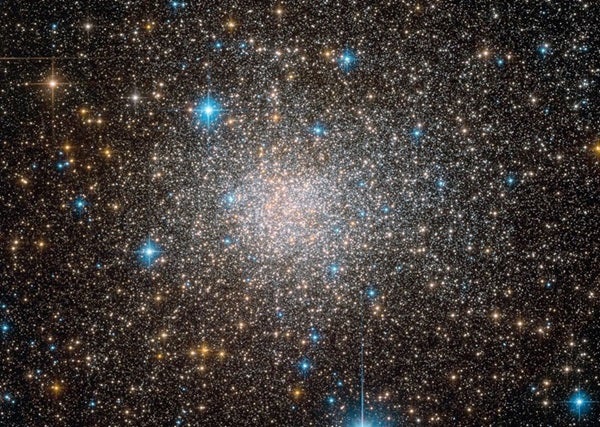Toward in our galaxy’s center lies Terzan 5, a celestial object shrouded in mystery. For decades, astronomers thought this conglomeration was a globular cluster of a million stars that all formed around the same time. Research published in 2009 put that classification in jeopardy, and a study published yesterday rips that title away from Terzan 5.
It turns out that the system hosts two populations of stars that formed at vastly different time periods. Astronomers now believe this system is a 12-billion-year-old fossil, holding only 1 percent of its past mass, and a relic of the first building blocks that assembled the Milky Way.
To measure the ages of these stars, researchers turned to a common tool in stellar astronomy: the so-called color-magnitude diagram. The astronomers gathered detailed information about thousands of stars at the center of Terzan 5 and compared the stars’ luminosities (or, magnitude) to their colors. Because a star’s color is based on its temperature, and its temperature depends on the star’s mass, scientists can easily calculate the star’s mass. The connection goes deeper, still.
“Depending on its initial mass, a star has a very precisely determined fate,” says team member Davide Massari of Università di Bologna in Italy. That means the astronomers can predict how and, more importantly for this study, when stars’ temperatures and luminosities would change. Then, they compare the observed temperatures and brightness to the predicted characteristics to find out what point the stars are at in their lives. “This allows us to use the colour-magnitude diagram as a clock,” he adds.
The researchers’ stellar clock showed two ages. The stars with more pristine material are 12 billion years old, while the stars made with element-rich gas are 4.5 billion years old. When Terzan 5 formed its first stars 12 billion years ago, those stars grew from the same pristine material.
The stars in that population that had more mass burned through their gaseous material faster while converting their gas into heavier chemical elements. At the end of their lives, those suns exploded as supernovae. Those blasts themselves fused even heavier elements, like iron, out of those stars’ material; the supernovae also spew the element-rich gas into space. And later, at the epoch 4.5 billion years ago, another generation of stars formed from that element-rich gas.
The two ages reveal another characteristic of Terzan 5: its original mass, 12 billion years ago. When a supernova explodes, it sends material out at high-speed. “To retain the supernova ejecta, you need a very huge mass,” says the study’s lead author Francesco Ferraro, also of the Università di Bologna. Globular clusters wouldn’t have enough mass, and thus a strong enough gravitational pull, to hold onto that gas. But Terzan 5 kept the material in its gravitational clutches, and that gas incorporated into the next stellar generation billions of years later. The astronomers estimate the stellar system was once 100 times its present-day mass, and it would have weighed in at 100 million times our Sun’s mass. “Terzan 5 is not a globular cluster,” says Ferraro. “It’s a remnant of a large structure that was formed at the time in which the central part of our galaxy formed — 12 gigayears ago. This is why we call it a fossil.”
Terzan 5’s original mass was still much smaller than the Milky Way’s current mass (about a trillion times that of our Sun’s), but it shows how our galaxy likely formed — from small building blocks clumping together into larger ones. Astronomers see evidence of this assembling process when they look at photographs revealing the light of the earliest galaxies from 12 to 13 billions of years ago. Terzan 5’s current chemistry and original mass match what they’ve seen in those still-conglomerating galaxies. These pieces of evidence suggest that Terzan 5 is a fossil from one of the first structures formed in the Milky Way, and acting as a connection between today’s universe and the long-past cosmos.










